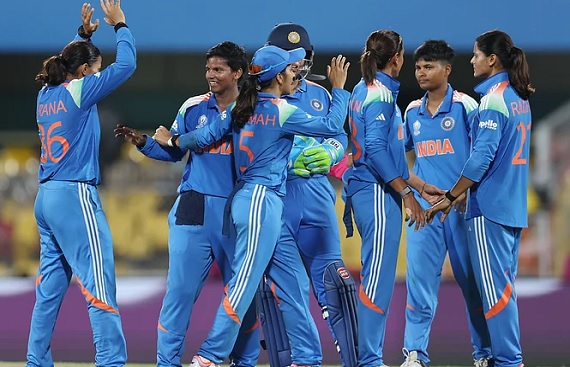Why This Year's Women's World Cup Is a Game-Changer for India

- India leads WC 2025 with dominant wins over Sri Lanka and Pakistan
- Cultural and economic impact boosts tourism, sponsorships, and women’s visibility
- Inspiring girls with record viewership and grassroots programs empowering young talent
In the electric atmosphere of Colombo’s R. Premadasa Stadium on October 5, 2025, Harmanpreet Kaur’s triumphant bat raise after India’s 88-run routing Pakistan wasn’t just a victory it was a clarion call. The roar from a diverse crowd of Indian expatriates, local supporters, and global cricket fans signaled something bigger than a group-stage win in the ICC Women’s Cricket World Cup 2025. Co-hosted across India and Sri Lanka, this tournament is a cultural juggernaut, reshaping gender norms, fueling economic growth, and redefining India’s sporting identity.
With India leading the points table after two commanding victories, this World Cup is not just a cricket event it’s a revolution, uniquely positioned to elevate women’s cricket in a nation where the sport is akin to religion.
A Historic Stage for Indian Cricket
![]()
India’s role as co-host, alongside Sri Lanka, marks its fourth time welcoming the Women’s ODI World Cup (after 1978, 1997, and 2013). This time, it’s different.
The tournament is conducted in iconic cities such as Guwahati, Navi Mumbai and Hyderabad and turns the regional cities into international arena. New training facilities, improved stadiums, and broadcast prepared installations indicate that the infrastructure is investing in the long-term prospect of women engaging in cricket.
Compared to previous editions, the 2025 event utilizes the cricketing popularity of India to promote South Asian women’s in the game as a tool of regional cooperation and to present the passion of the subcontinent to the world. The sold-out opener in Guwahati, surpassing T20 attendance records, proves the sport is no longer a niche it’s a cultural juggernaut.
India Tops Table with Stunning Wins
India’s on-field performance has set pulses racing. Their campaign kicked off with a 59-run Duckworth-Lewis-Stern victory over Sri Lanka in Guwahati on September 30, a match marking the Assam Cricket Association Stadium’s women’s ODI debut. Smriti Mandhana’s elegant 78 not out and Deepti Sharma’s incisive 3-23 showcased a team in sync.
The Pakistan clash on October 5 was a statement, Shafali Verma’s gritty 112 and Jemimah Rodrigues’ explosive 65 off 42 powered India to 277/6, before debutant Kranti Goud’s 4-32 skittled Pakistan for 189. With four points and a +1.515 net run rate, India sits atop the eight-team table, tied with Australia but ahead on head-to-head. As they gear up for England on October 9 in Visakhapatnam, the blend of Harmanpreet’s leadership and Richa Ghosh’s dynamism signals a squad poised for the title.
Cricket Becomes a Stage for Change
![]()
Beyond the boundary, the World Cup is rewriting societal scripts in a nation where patriarchal norms often limit women’s visibility. Live broadcasts on Star Sports and Disney+ Hotstar have drawn over 200 million viewers in India, outstripping the 2022 final’s global audience and rivaling men’s IPL openers.
The August 11 Trophy Tour, spanning Mumbai to Guwahati with icons like Mithali Raj, amplified the buzz, while the Guwahati opening ceremony with Shreya Ghosal singing the soulful anthem ‘Bring it Home’, made 45,000 fans pour in to a venue where the epic had been played upon. This exposure is breaking stereotypes, demonstrating to young girls that that cricket’s hallowed turf is theirs too.
Also Read: India's Unstoppable Spirit Wins Historic Ninth Asia Cup 2025
Cricket Brings Millions to Cities and Streets
The tournament is a financial gold rush. The local economies have benefited through tourism, hospitality and merchandise by hosting 20 of 31 matches (including Colombo, as the neutral venue, India-Pakistan). The occupancy of Indore and Guwahati hotels is 95 percent and the sellers on the streets are selling blue jerseys more than the sweets on festivals.
Sponsorships from Tata and Reliance underscore women’s cricket’s $500 million annual valuation a 300% rise since 2020 while the WPL’s 2024 crowds (30,000 per match) prove commercial clout. The $4.48 million winner’s purse could fund academies, but the real gain is elevating women’s leagues to IPL-level prominence.
Breaking Barriers for Women in Cricket
![]()
Beyond runs and wickets, the 2025 World Cup is a cultural revolution. Cricket in India has long been a male-dominated domain, with women’s games often relegated to secondary pitches or limited airtime. This tournament changes that. The existence of such players as Kaur, who combines grit and grace, plants a seed disproving stereotypes and motivating girls to overcome social norms.
With the support of women programs by BCCI in cricket activities, grassroots programs are growing in the undervalued areas, and they provide coaching and equipments to young talents. The focus of the World Cup is made more captivating by the cheap tickets and national television coverage making sure that girls in rural Bihar or in city Mumbai don’t think of being in a game of cricket as farfetched. This could be a breakthrough that opens the field that was traditionally male dominated and make a difference in the game in India.cture.
The Finish Line
As the tournament races toward its October 26 league climax, with semi-finals in Navi Mumbai and a potential Indore final, the stakes transcend silverware. In a nation where women’s sports participation lingers at 20%, this World Cup could double that by 2030, per ICC estimates. It’s a mirror reflecting India’s untapped potential, proving that when women take the field, the nation transforms. Win or lose on November 2, the 2025 Women’s World Cup has already bowled a googly at convention, cementing women’s cricket as India’s boldest frontier.
